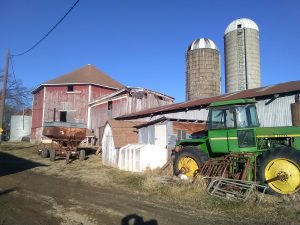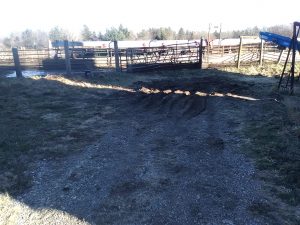Marengo fire is bookend for county barn history
By Gregory Harutunian For Chronicle Media — January 3, 2019
This rare example of an octagonal barn was built in the 1840s by Fred Hatch. (Photo courtesy of Fred Bielow)
An emergency 911 call was made at 10:51 a.m. Nov. 14, from the owner of a barn located at 25208 River Road in rural Marengo, alerting authorities to a fire in the structure.
Personnel and equipment from the Marengo Fire Protection District were dispatched to the site, along with requests for resource assistance by other departments through the Mutual Aid Box Alarm System. Fire crews eventually left at approximately 12:40 p.m., with only salvaged lumber and the foundation stones remaining.
Records indicate the barn was built in 1897 by R.B. Willard, and although partially collapsed in the middle, it was the oldest remaining example of “round-style barn” construction extant left in the state of Illinois. Historic barn and storage structures are part of the agricultural legacy in McHenry County, along with having the distinction of the first silo ever built in the United States.
“It was a round barn, collapsed already in the center,” said Fire Chief Robert Bradbury, of the Marengo Fire Protection District. “It was going to be torn down. The gentleman reclaiming the wood had a little fire going, to burn excess wood. That was what caught the barn on fire. Winds changed on him, and no investigation is taking place, based on his statement.”
“There were several fire protection districts that responded, including us, the Union Fire Protection District, Harvard … Capron came with an ambulance, but there were no injuries. The Woodstock Fire and Rescue District came out, too, but they turned around,” he said. “All that’s left there is the stone foundation of the barn.”
The collapse allegedly occurred in 2008, under the weight of a winter snowfall. Scheduled to be torn down, the individual on-site, Rick Rath, had been given permission to gather the barn wood. According to reports, several posts had been reclaimed when the wind shifted on the fire and caught onto the barn. The property owner was in another field harvesting crop, at the time, and not in the immediate area.

The first upright silo ever built in the United States was on this spot, torn down in the 1980s, and all traces eroded away. (Photo courtesy of Fred Bielow)
“Back in the day, I wrote a story about that barn…even poked my head up into the loft, although the floor was already getting bad, twenty years ago,” said Kurt Begalka, the Mc Henry County Historical Society’s administrator. “The cupolas on the roof had fallen off and were cockeyed that water was getting in. That is the beginning of the end for barns. However, as I wrote about in the column, there are ways to nip this at the bud…provided you don’t let it go too far.
“Metal roofs can be placed directly over the shingles. I’ve seen it done,” he said. “It saddens me because these barns are a piece of history, most from an era when it was more important to have electric lights in the milking parlor than in the living room.”
The barn’s story was told in the “McHenry County Self-Guided Barn Tour,” a celebration of “The Year of the Barn,” distributed by the Union-based historical society in 1997.
“The round barn … stands in stark contrast to its gable and gambrel-roof counterparts along this tour. A 1901 Marengo newspaper article extols its virtues as ‘the most convenient barn in northern Illinois because it contains more room for the lumber consumed and the money expended than any barn ever constructed in this part of the country.’ This tri-level barn is 240 [feet] in circumference and sits atop a 2[-foot] fieldstone foundation. The lower level was designed to house horses and cattle.
“It offered iron racks for hay, iron feed boxes, and iron boxes for salt. The second level was designed for milking 64 dairy cows. There was a circular granary in the center of the barn, loft space (on the third floor) for 200 tons of hay, and a permanent corn crib for 3,000 bushels of corn. The whole barn was ventilated with a 2-foot square air shaft which extended 80 feet from the lower level to the cupola on the roof. Milk was stored in milk cans in a cement vat and cooled with water from the well.

In Spring Grove’s Thomas Park, a bronze plaque commemorates and tells the story of the country’s first upright silo. (Photo by Gregory Harutunian/for Chronicle Media)
“Following the Civil War, such things as louvers, ventilators, silos, sliding doors, manure carriers, hayfork tracks, and lightning rods (all designed to increase safety, sanitation, and air circulation) were added to barns. Although extolled during its time, the round barn was not easy to construct, clean, or fill with hay. Very few round barns were built in this county, and very few remain.
The cryptic last sentence also extends to a forgotten piece of history … the former Hatch Farm, now on inaccessible private property. The 1997 guidebook said, “The first upright silo built in the United States was located on the outskirts of Spring Grove in Burton Township. Erected inside a barn, it was built by Fred Hatch, and his father, Lewis. Lasting until 1980, portions of the rock and mortar foundation are the only existing traces.”
Over the decades, even those foundation traces have disappeared, broken down by the elements or buried. What does remain are outbuildings and an octagonal (eight-sided) barn that Hatch built in the 1840s enclosing a feed mill and grain stalls where hay and grain were stored above.
The Lyle Thomas Park and Landing, along Nippersink Creek at the Blivin Street Bridge, west of Main Street in Spring Grove, has a small square. A bronze plaque and pillar depicting the Hatch Silo was placed there by the county historical society as a landmark site, and recounts the silo’s unique tale of construction. Such history now lives only in books and dog-eared photographs.
“A few years back, the village of Marengo tore down a pristine, rainbow-truss (open span) barn to make room for a salt storage facility,” said Begalka. “They are not building any more historic barns. Ironically, their future may hinge on the use of modern roofing materials and the willingness of preservationists and pragmatists to compromise. That way, history retains a rightful place at the table.”
Ad 1 – 300×250 – Google ROS
Trending News
 Chicago teen charged in fatal ...A 19-year-old Chicago man has been charged in connection with a fatal ...
Chicago teen charged in fatal ...A 19-year-old Chicago man has been charged in connection with a fatal ... Government, defense spar as child ...With the criminal trial of Elburn veterinarian Adam Stafford King fast approaching ...
Government, defense spar as child ...With the criminal trial of Elburn veterinarian Adam Stafford King fast approaching ... Challenges persist for women, minorities ...PEORIA — For 60 years, SkillsUSA Illinois has held workforce development competitions ...
Challenges persist for women, minorities ...PEORIA — For 60 years, SkillsUSA Illinois has held workforce development competitions ... Chicago officials seek to allay ...Chicago officials tried to reassure Pilsen neighborhood residents that they are doing ...
Chicago officials seek to allay ...Chicago officials tried to reassure Pilsen neighborhood residents that they are doing ...
Ad 3 – 300×600 – Post Pages – Google ROS
Ad 2 – 300×250 – Google ROS



